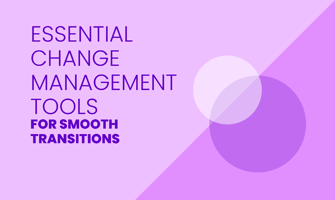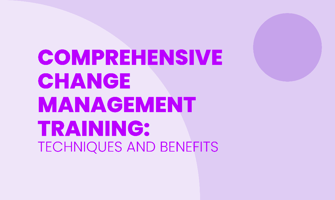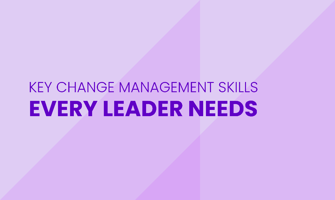Change management involves guiding individuals, teams, and organizations through a transition from...
Exploring Different Types of Change Management: Transformational, Transitional, and Developmental
Understanding the types of change management helps organizations adapt to new conditions and challenges. Whether dealing with major overhauls, specific process updates, or continuous improvements, knowledge of these types is key. Change management ensures that changes are implemented smoothly and effectively, minimizing disruption and maximizing benefits.
This article explores the different types of change management—transformational, transitional, and developmental. By understanding these types, you can better align your organization's goals with the right strategies, ensuring smoother transitions and more successful outcomes.
Want to know more about Change Management? Read What is Change Management? An Introductory Guide for all the details.
1. Transformational Change Management
Transformational change management involves a deep, systemic shift in the identity of an organization. It focuses on reimagining the entire organization rather than just replacing parts.
This type of change targets transformation at a foundational level, often driven by external pressures such as market disruptions or technological advancements. The goal is to achieve significant improvements in performance and competitiveness.
Characteristics
Scope: Impacts the entire organization at every level.
Focus: Requires a thorough reevaluation and reshaping of core aspects such as values, beliefs, and behaviors.
Nature: Radical in nature, introducing fundamental shifts in paradigms and mindsets.
Duration: Long-term, often unfolding over several years.
Drivers: Driven by significant external shocks, such as technological revolutions or dramatic market shifts.
Implementation Strategy
Conduct Comprehensive Impact Analysis: Conduct Comprehensive Impact Analysis: Assess how the transformational change will affect various layers of the organization by examining departments, teams, and individual roles. Use techniques like SWOT analysis (Strengths, Weaknesses, Opportunities, Threats) and PEST analysis (Political, Economic, Social, Technological) to identify potential risks and opportunities. Employ tools like 180ops to streamline data integration and analysis, crucial for effective transformational change management. Use impact assessment tools to gain insights into how different departments and processes will be affected.
Develop a Detailed Change Roadmap: Outline specific steps, timelines, and milestones to provide structure to the transformation process. Use techniques like Gantt charts and project management software to plan and track progress. The roadmap should include short-term and long-term goals, resource allocation, and key performance indicators (KPIs) to measure success. KPIs may include metrics such as employee engagement levels, productivity rates, customer satisfaction scores, and financial performance indicators like revenue growth or cost savings.
Establish a Dedicated Change Management Team: Form a specialized team responsible for overseeing and executing the transformation process. This team should include change champions from different departments to ensure broad representation and buy-in. Buy-in refers to gaining agreement and support from stakeholders at all levels of the organization. Collaboration platforms can facilitate communication and coordination among team members, ensuring that everyone is aligned and working towards common goals.
Regularly Communicate Progress: Maintain transparency with stakeholders by regularly updating them on milestones achieved and challenges faced. Use techniques like regular town hall meetings, newsletters, and dashboards to share progress updates. Communication tools such as email marketing platforms and intranet portals can help disseminate information effectively. Keeping stakeholders informed fosters trust and ensures that everyone remains engaged and motivated throughout the transformation process.
Transformational change management is about creating a new future for an organization, often in response to far-reaching external pressures.
2. Transitional Change Management
Transitional change management handles the organization's move from its current way of doing things to a new and improved state. It represents a planned reorganization, a carefully mapped-out transition from one operational structure or system to another, intended to enhance efficiency or embrace new technologies.
This type of change is often necessary to stay competitive and comply with evolving industry standards.
Characteristics
Scope: This approach is pinpointed, affecting specific processes or departments rather than the entire organization.
Focus: Concentrates on particular areas that require updating or replacing.
Nature: Systematic and orderly transformation is the hallmark of transitional change.
Duration: Typically spans several months to a few years.
Drivers: Internal drivers like the need for improved efficiency or external ones like new regulatory demands can catalyze transitional change.
Implementation Strategy
Develop a Step-by-Step Transition Plan: Create a detailed plan outlining each phase and milestone of the transition. Use techniques such as process mapping and gap analysis to identify what needs to change and how to get there. Process mapping involves visualizing the current process to understand its steps and identify inefficiencies. Gap analysis compares the current state with the desired future state to highlight areas that need improvement. Tools like project management software and workflow automation can help manage the transition smoothly.
Train Employees on New Systems and Processes: Conduct comprehensive training sessions to ensure employees are proficient in new procedures and technologies. Training topics can include new software systems, updated workflows, compliance with new regulations, and best practices for using new tools. Use e-learning platforms and virtual training simulations to provide flexible and interactive training options. Provide ongoing support through help desks and internal knowledge bases.
Pilot Testing: Implement a trial run in a controlled environment to identify potential issues before full-scale rollout. Use techniques such as pilot programs and sandbox environments to test the new system. A pilot program involves implementing the change in a small, controlled group within the organization to gather insights and feedback. Sandbox environments allow users to experiment with the new system without affecting real operations. Gather feedback by asking specific questions about usability, functionality, and any encountered issues.
Establish Clear Feedback Mechanisms: Create structured channels for collecting feedback from employees during the transition. Use surveys, focus groups, and feedback forms to gather detailed insights. Ask for feedback on the ease of use of new systems, any challenges faced, and suggestions for improvement. This information helps in making necessary adjustments and ensures a smoother transition process.
![]()
3. Developmental Change Management
Developmental change management focuses on fine-tuning and enhancing the existing business model, processes, or capabilities within an organization. It aims to take what already works and make it better, incrementally and continuously.
This approach is crucial for maintaining organizational agility and competitiveness, ensuring that the organization can adapt to changes and improve over time.
Characteristics
Scope: These changes generally touch on specific areas or functions rather than overhauling the whole organization.
Focus: The goal is to embark on a path of continuous improvement and refine existing processes and skills.
Nature: Incremental, aiming to improve quality and efficiency step by step.
Duration: This can be short-term and ongoing, depending on the objectives and area of focus.
Drivers: Driven by the need for growth, better performance, and efficiency within the organization.
Implementation Strategy
Implement Continuous Improvement Programs: Methods like Lean or Six Sigma can play a pivotal role in driving progress and efficiency. Lean focuses on eliminating waste and improving process flow, while Six Sigma emphasizes reducing variability and improving quality. Tools such as value stream mapping and DMAIC (Define, Measure, Analyze, Improve, Control) can be used to systematically identify areas for improvement and implement changes.
Conduct Regular Skills Assessments: An ongoing evaluation of employees' skills ensures that training can be provided to fill any emerging gaps. Techniques such as skills matrices and competency assessments can help identify areas where employees need development. Regular training programs and professional development workshops can then be tailored to address these needs, ensuring that the workforce remains capable and competitive.
Set Clear Performance Metrics: Objective benchmarks help to measure efficiency and success in improvement initiatives. Metrics such as cycle time (the total time taken to complete a process from start to finish) and defect rates (the frequency of errors or defects in a process) can provide insights into the effectiveness of developmental changes. Using dashboards and performance tracking software, organizations can monitor these metrics and make data-driven decisions to enhance processes further.
![]()
When to Choose Each Type of Change Management
1. Nature of the Change Needed
Transformational Change: This is needed when an organization requires a major reconfiguration of its identity and strategy, involving deep, systemic shifts across the entire organization.
Transitional Change: Implemented to make necessary adjustments within specific departments or processes, such as adopting new technologies or improving efficiency.
Developmental Change: Best for improvements and optimizations within the existing framework, focusing on continuous improvement and refining current practices.
2. Organizational Goals
Transformational Change: Aligns with the goal of radically realigning the organization to long-term strategic visions, such as overhauling the business model or entering new markets.
Transitional Change: Serves medium-term objectives like operational overhauls or embracing updated technologies, such as migrating to a new enterprise resource planning (ERP) system.
Developmental Change: Supports incremental goals focused on enhancing current competencies and processes, such as implementing continuous improvement programs or updating employee skills.
3. Resource Availability
Transformational Change: Requires substantial time, money, and personnel, involving major investments in new technologies, training, and process reengineering.
Transitional Change: Needs moderate resources, focusing on specific projects with defined scopes, such as new tools and training on a smaller scale.
Developmental Change: Requires minimal resources, relying on the steady application of existing assets for continuous improvement, like regular training sessions, minor process tweaks, or incremental technology upgrades.
4. Risk Tolerance
Transformational Change: Suitable for organizations willing to take high risks, given its potential for disruption and unforeseen challenges but with significant rewards.
Transitional Change: Offers a balanced risk profile with structured implementation, making it a safer choice for substantial changes within a controlled environment.
Developmental Change: Poses the least risk, with adjustments made incrementally to minimize potential negative impacts, allowing steady improvement without major disruption.
5. Urgency and Pressure
Transformational Change: Needed in situations of high urgency due to pressing external factors, such as market disruptions, regulatory changes, or competitive pressures.
Transitional Change: Suitable for important but less immediate organizational shifts, such as planned technology upgrades or process improvements that are necessary but not urgent.
Developmental Change: Best employed when there is no immediate pressure, focusing on steady, manageable enhancements over time, ideal for gradual and sustainable improvement.
![]()
Conclusion
Change management is essential for your organization's ability to adapt, survive, and thrive. Understanding the different types of change management—transformational, transitional, and developmental—helps you choose the best approach for your current situation and future goals.
By understanding these types of change management, you can keep your organization competitive, improve processes, and achieve long-term success in a constantly changing business world.
FAQs
How do ITSM teams categorize changes in an organization using Atlassian tools?
ITSM teams categorize changes into standard changes, normal changes, and emergency changes. Team management tools help manage these modern change management types efficiently. Regular reports and risk assessments improve the change management process.
What are the main types of changes explained for agile ways of working?
Agile ways categorize changes into standard changes, normal changes, and emergency changes. Managing these changes effectively requires models and risk assessments. Regular improvement of the overall supply chain organization is key to success.
What challenges do organizations face when practicing change management during uncertain times?
Organizations face challenges like managing standard changes, normal changes, layoffs, and emergency changes. Effective risk assessment and communication are vital for established employees as well as new hires. Leadership models, communicating responsibility, and training programs support smooth transitions and transformations.
How can Atlassian tools assist in deploying organizational change and managing emergency changes?
Atlassian tools like Jira help deploy organizational change by managing change like standard changes and emergency changes efficiently. Using risk assessment and reports ensures a smoother process like onboarding, handling clients, hiring, etc. Continuous improvement is also supported.
How does knowledge management play a role in handling change requests and standard changes?
Knowledge management helps handle change requests by providing clear guidelines for standard changes and normal changes. It ensures better risk assessment and improvement. Regular reports help in monitoring progress, analytics, employee’s responsibilities, and workload, and making necessary adjustments.




